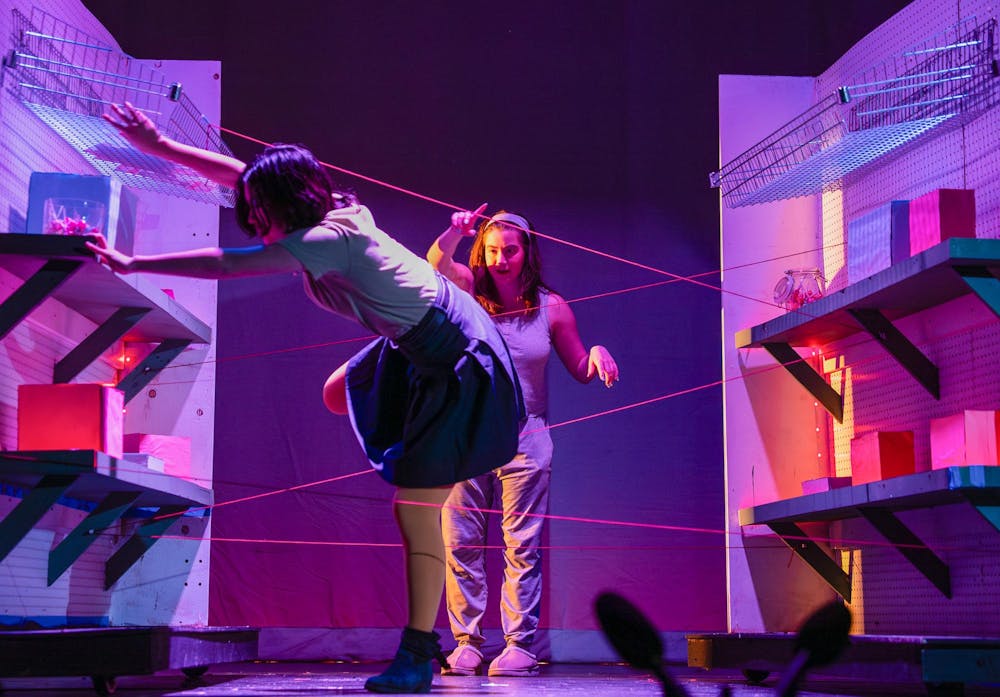Walking into Theatre Intime for the dress rehearsal of “Missing Dog, Very Helpful” on the Wednesday night before its performances, I was taken aback by the tone of the scene before me. As the sound effect of powerful raindrops thundered overhead, a light was cast center-stage, revealing a silhouette working at an office desk, the keystrokes resonating across the hall. Slowly emerging from behind the curtain clutching an umbrella, the Dreamer, played by Kailani Melvin ’28, walked up to a bus stop, staring into the distance as the lights cut to black.
It was only shortly afterwards that I realized this was a brief rehearsal for a moment much later in the play. I was never meant to see this last-minute tech check. Even so, it fit seamlessly into the storyline, cutting off at the right moment to set off the play’s cyclical narrative that resembles “Groundhog Day.”
In “Missing Dog,” the Dreamer experiences the same lucid dream of a supermarket every night before it is reset when they wake up to catch their bus. The play itself tells the story of a night when the Dreamer went further into the dream than normal, forging a relationship with their own mental construct before being forced to wake up and have the entire scene reset.
The atmosphere created by the play’s actual opening scene seems to taunt one’s perception of reality. The Dreamer walks into a grocery store with a robotically polite Clerk, portrayed by Ariel Chen ’28, behind the counter as the eerily near-empty shelves bask in the dim, fluorescent-mimicking light. The intensity of the scene’s uncanny atmosphere resonates equally among both the Dreamer and the audience.
The initial interaction between these two characters — the only two in the entire show — sets up the necessary tension for what would go on to become a complex journey of self-discovery for the Dreamer. The body language displayed throughout this first meeting goes a long way, with the Clerk’s tiptoeing and hand placement evoking a mix of juvenile excitement and unfamiliarity with the new level of interaction they are experiencing.
The play introduces two important metaphors within its opening sequence: the bus the Dreamer says they have to catch and the titular stuffed dog reportedly in charge of the store and, by extension, the dreamspace most of the narrative takes place in. In regard to the former, it is hard not to draw a comparison to the train from Christopher Nolan’s “Inception,” where the protagonist and his lover use a train to escape their shared dream. Unlike its cinema counterpart, however, the vehicular method of escaping a dream in “Missing Dog” is shown to be a real object — its arrival being a tangible event in the waking world that is able to influence the dreamscape, rather than the other way around.
As the Dreamer and the Clerk begin to explore the bizarrely constructed and ever-evolving recurring dreamscape of the supermarket in hopes of locating the missing stuffed dog, transition scenes have on-stage prop handlers rearrange the two shelves into a surprisingly large number of unique positions. Each of these various positions suit the “challenges” that the dream presents, be it a blocked-off corner of the store or an aisle filled with spy-movie-cliché lasers, which end up being harmless yarn — something that is gradually turned into a running gag. Despite only filling time in between narrative-heavy scenes, these transitions played an important part in preserving the atmosphere of the store.
“We treated the transitions almost as independent scenes, implementing some simple ‘self-choreography’ as well as unique lighting and sound cues for each transition. I think they ended up imbuing the grocery store with such soul,” director Melody Cui ’27 said.
In stark contrast to the dynamic and chaotic events leading up to this point, the play slows down about two thirds of the way through to make adequate room for the Dreamer’s introspective and romantic arcs.
Talking about their favorite script-to-stage adaptation, playwright Kristen Tan ’26 references how the eventual character name reveal — a point where the Dreamer reflects on their own identity — features the two actors’ real first names.
“I honestly wrote that because I was too lazy to come up with real names, and then when I heard them do it in the first read through, it was actually the most emotional moment in the play for me,” she said. “It actually ended up being so incredibly vulnerable in that moment, and I never expected that to be my favorite part of the show, but it is.” The slow pacing of the characters’ drinking and name reveal scenes provides enough time and dialogue space for the Dreamer’s internal struggles to develop without descending into being unnecessarily dramatic.
Much like the moments preceding it, the romantic tension between the Dreamer and the Clerk — now made clear to be the Dreamer’s own construct — is executed naturally and plays well into the overarching theme of the Dreamer and their agency over their own life. In an emotional and bittersweet farewell, the two part, abandoning the relationship that had been so carefully constructed over the course of the night. The titular missing dog, eventually found by the pair in its lair, is left undisturbed at its desk.

On the way home that night, I thought about the realization that the Dreamer had at the bus stop in the penultimate scene. As seen with the bus coming for the Dreamer or the same store they dreamt of every night, it is impossible to avoid the monotony of life. Even so, there are moments where we can find surprising joy in something we consider mundane. Perhaps that is what the Dreamer’s subconscious was hinting at when a simple conversation with the dreamt-up Clerk led to an eye-opening journey for the Dreamer. Dreams may fade away in the morning, but taking that first step in the waking world is what can turn your life around in ways you wouldn’t have thought possible.
Eric Mohorea is a contributing writer for The Prospect and a member of the Class of 2028. He can be reached at em4523[at]princeton.edu.
Please send any corrections to corrections[at]dailyprincetonian.com.








